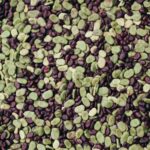Fall is a time when many gardeners start to wind down and prepare their gardens for the winter. However, fall can also be a great time to grow beans, as long as you know how to do it properly. Beans are an excellent crop to grow in the fall, as they are easy to grow and provide a good source of protein and fiber.
To successfully grow beans in the fall, there are a few things that you need to keep in mind. First, you need to choose the right variety of bean. Some varieties of beans are better suited for cooler weather than others, so it’s important to do your research before planting. Second, you need to make sure that your soil is prepared properly. Beans require well-draining soil with plenty of organic matter, so be sure to add compost or other organic material before planting. Finally, you need to pay attention to watering and fertilizing your beans properly throughout the growing season. With these tips in mind, you’ll be able to grow a bountiful crop of delicious beans this fall!
Choosing The Right Variety Of Bean For Cooler Weather
As the summer season comes to an end, it is time to start planning for your fall garden. One of the most popular crops to grow during this time are beans. However, not all bean varieties are suited for cooler weather. It’s important to choose a variety that has cold weather tolerance in order to ensure successful growth.
There are several bean varieties that are known for their ability to thrive in colder temperatures. One such variety is the Blue Lake Bush Bean, which can withstand temperatures as low as 40 degrees Fahrenheit. Another great option is the Contender Bush Bean, which can handle even lower temperatures and still produce a bountiful harvest.
It’s important to note that while some bean varieties may be labeled as “cold tolerant,” they still require warm soil temperatures in order to germinate properly. Before planting any beans, make sure that your soil has reached at least 60 degrees Fahrenheit. You can use a soil thermometer to determine the temperature of your soil.
Now that you have chosen the right variety of bean for cooler weather, it’s time to prepare your soil for optimal growth.
Preparing Your Soil For Bean Growth
When preparing your soil for a fall crop of beans, it is important to choose the right soil to ensure healthy plant growth. Ideally, a soil that is rich in organic matter and well-draining is best. Additionally, optimizing your soil pH is important to ensure optimal nutrient uptake. A soil pH between 6.0 and 7.0 is recommended for most bean crops.
Choosing The Right Soil
Achieving a bountiful fall crop of beans starts with preparing the soil. Soil composition is a crucial factor to consider when choosing the right soil for bean growth. Beans thrive in well-drained soil that is rich in organic matter, such as compost or aged manure. The addition of organic matter helps improve the structure and texture of the soil, allowing for better root development and nutrient uptake.
Another important consideration when selecting soil for beans is pH levels. Beans prefer slightly acidic soil with a pH range between 6.0 to 6.8. Soil that is too alkaline can lead to nutrient deficiencies, while overly acidic soil can stunt plant growth and reduce yield. It’s essential to test your soil’s pH levels before planting and make necessary adjustments by adding lime or sulfur accordingly.
In summary, selecting the right soil for bean growth involves considering both its composition and pH levels. By choosing well-drained, organic-rich soil with a slightly acidic pH level, you are providing an optimal environment for your bean plants to grow and thrive. With proper preparation, you’ll be on your way to a successful fall harvest of delicious beans!
Optimizing Soil Ph
Preparing your soil for bean growth involves several essential factors that must be considered. One of the most critical aspects that gardeners must pay attention to is the pH levels of their soil. Soil pH is a measure of its acidity or alkalinity and is an important factor in determining bean plant nutrition. When the soil’s pH level is not optimal, it can lead to nutrient deficiencies, which can result in poor plant growth and reduced yields. Therefore, optimizing soil pH is crucial to ensure that your bean plants receive adequate nutrition.
Using soil amendments is one way to optimize soil pH levels for bean growth. Adding lime to overly acidic soil helps increase its pH level, making it less acidic and more alkaline. On the other hand, adding sulfur to high-alkaline soil helps make it more acidic. Gardeners should conduct a soil test before planting beans to determine their soil’s current pH levels and assess whether any adjustments are needed.
Optimizing soil pH levels for bean growth can significantly impact plant health and yield. By providing an ideal environment with favorable acidity levels, gardeners can ensure that their beans receive adequate nutrition throughout their growing season. Incorporating organic matter into your soil along with the proper use of amendments will create a healthy foundation for your bean plants’ success. With these tips in mind, you’ll be on your way to a bountiful harvest of delicious beans!
Adding Organic Matter To Improve Soil Drainage
One of the main factors that can affect the growth and productivity of any plant is soil drainage. Beans, like any other plant, require well-draining soil to grow properly. If your soil is too compacted or has poor drainage, you may need to add organic matter to improve it.
Adding organic matter to your soil can help improve its structure, increase water and nutrient retention, and promote healthy microbial activity. Composting techniques such as vermicomposting or hot composting can produce high-quality organic matter that you can add to your garden beds. Alternatively, you can use mulch made from leaves, grass clippings, or straw as a top dressing around your plants.
By improving the quality of your soil through the addition of organic matter, you can create an environment that promotes healthy root development and better nutrient uptake for your beans. Additionally, adding mulch around your plants can help retain moisture in the soil and reduce evaporation during hot weather conditions.
In summary, adding organic matter to improve soil drainage is a crucial step in growing a successful fall crop of beans. Whether through composting techniques or using mulch as a top dressing around your plants, incorporating organic matter into your garden beds can lead to healthier plants with increased productivity. In the next section, we will discuss how proper watering techniques are essential for maintaining healthy bean plants.
Watering Your Beans Properly
As the saying goes, “Water is life.” This holds true in organic gardening as well, particularly when it comes to growing a fall crop of beans. Watering your beans properly is crucial to ensure their optimal growth and yield.
One important aspect of watering your beans is understanding the best time to water them. It’s best to water early in the morning or late in the evening when temperatures are cooler and evaporation rates are lower. This allows the soil to absorb the water more effectively, providing moisture for your plants when they need it most.
Another key factor in proper watering is mulching. Mulching helps to retain moisture in the soil by preventing evaporation and reducing weed growth. It also helps regulate soil temperature, keeping it cool during hot weather and warm during cooler temperatures. By using organic mulch such as straw or leaves, you can provide a natural source of nutrients for your plants while also protecting them from pests and diseases.
As we’ve seen, proper watering techniques play a vital role in growing healthy fall crops of beans. By understanding the importance of mulching and knowing when to water your plants, you can ensure that they receive the moisture they need for optimal growth and yield. In our next section, we’ll explore how fertilizing your beans can further enhance their growth potential.
Fertilizing Your Beans For Optimal Growth
- When preparing the soil for a fall crop of beans, it is important to pay attention to pH levels and nutrient content.
- Incorporating high-quality organic matter into the soil before planting will help to ensure the soil is balanced and has adequate nutrients for the beans to feed on.
- Adding a balanced fertilizer before planting will also provide the beans with the necessary nutrients for healthy growth and development.
- After planting, adding organic mulch around the bean plants will help to retain moisture and nutrients in the soil, improving the overall health of the plants.
Preparing The Soil
To grow a successful fall crop of beans, the first step is to properly prepare the soil. Soil preparation involves a series of steps that guarantee the soil has all the necessary nutrients and conditions for optimal growth. Before planting beans, it is essential to test the soil in order to determine its pH level and nutrient content. This will enable you to amend the soil accordingly and create an ideal environment for your plants.
Soil testing is an important process that involves analyzing your soil’s composition and nutrient levels. A professional soil test will help you understand what amendments are necessary for optimal plant growth. You can take samples of your soil to a local agricultural extension office or purchase a home testing kit from a garden center. Once you receive your results, you can begin preparing your soil by adding organic matter, such as compost or manure, and adjusting pH levels with lime or sulfur.
Soil preparation is critical when it comes to growing fall crops of beans. By testing and amending your soil, you’ll be able to create a healthy environment that promotes strong root development and ensures high-quality yields. Investing time in proper soil preparation will not only benefit your current crop but also improve the overall health of your garden for years to come.
Adding Nutrients
Once you have prepared your soil by testing and amending it, the next step to growing a successful fall crop of beans is fertilization. Fertilizing your beans will provide them with the necessary nutrients for optimal growth and yield. However, it is important to use organic fertilizers that are gentle on the environment and promote soil health.
One way to fertilize your beans is by adding compost to the soil. Composting benefits not only your plants but also the environment by reducing waste and improving soil structure. By incorporating compost into your soil, you’ll be providing your beans with essential nutrients such as nitrogen, phosphorus, and potassium. Another option is to use natural amendments such as bone meal or fish emulsion which are high in nitrogen and other nutrients.
It’s important to note that over-fertilizing can damage plants and harm the environment. Therefore, it’s essential to follow recommended application rates for any fertilizer or amendment you choose. By properly fertilizing your beans with organic options, you’ll not only ensure optimal growth but also contribute to a sustainable garden ecosystem for years to come.
Planting Techniques For Fall Bean Crops
Fertilizing your beans is crucial for optimal growth, but planting techniques also play a significant role in ensuring a successful fall crop. As an organic gardening expert, I recommend starting with selecting the right variety of bean that will thrive in your area during the fall season. Optimal planting should be done after the summer heat has passed and soil temperatures have cooled down to around 60-65°F.
When planting your fall crop of beans, it’s important to create ideal conditions that promote healthy growth. Begin by preparing the soil with organic matter such as compost or aged manure, as this provides necessary nutrients and improves soil structure. Next, make sure to plant your beans in an area that receives full sun exposure and has good drainage. Avoid areas prone to waterlogging or standing water as these can lead to root rot and other fungal diseases.
Finally, maintaining healthy bean plants throughout their growth cycle is crucial in ensuring a bountiful harvest. Regularly inspect your plants for any signs of pests or disease and take appropriate measures if needed. Water consistently but avoid overwatering as this can lead to root rot. Additionally, incorporate mulch around the base of your plants to help retain moisture and suppress weed growth. Remember that healthy bean plants produce more yield, so prioritize their care throughout the growing season for optimal results.
Maintaining Healthy Bean Plants
Watering bean plants should be done regularly, but not too much as this can lead to root rot and other diseases. Mulching is important for conserving soil moisture and reducing weeds. Fertilizing should be done with an organic fertilizer to provide the necessary nutrients for the plants. Pruning can be done to encourage bushier plants and encourage better yields.
Watering
Drip irrigation is the most effective way of watering beans in the fall season. It ensures that the plant gets enough water without overwatering or causing soil erosion. Drip irrigation involves a system where water drips slowly and directly to the roots of the bean plants. This method saves time, money, and reduces weed growth.
The frequency of watering depends on various factors such as weather patterns, soil type, and stage of growth. During hot and dry conditions, bean plants require frequent watering to prevent wilting. Watering once or twice a week is sufficient during cooler weather conditions. However, it’s important to monitor soil moisture levels regularly using a moisture meter to ensure that the plants are not over or under-watered.
In conclusion, maintaining healthy bean plants requires proper watering techniques. Drip irrigation is an efficient way of delivering water directly to the roots while avoiding soil erosion and conserving water. The frequency of watering should be adjusted depending on weather patterns, soil type, and stage of growth to ensure that bean plants thrive in your fall garden.
Mulching
To maintain healthy bean plants in your fall garden, it’s essential to use proper watering techniques as discussed earlier. However, another important aspect of plant care is mulching. Mulching involves covering the soil around the plant to conserve moisture and prevent weed growth.
There are several benefits of mulching for fall bean crops. Firstly, it helps to regulate soil temperature by keeping it warm during cooler weather conditions and cool during hot weather. Secondly, mulch reduces water evaporation from the soil, which can be particularly useful for dry climates or when beans are planted in sandy soils. Lastly, mulching helps to suppress weed growth, which can compete with your bean plants for nutrients and water.
When choosing a type of mulch for your fall bean crops, there are various options to consider. Organic materials such as straw, leaves, grass clippings or wood chips can be used as a natural mulch source. These materials break down over time and add organic matter to the soil as they decompose. Alternatively, synthetic materials such as plastic or landscape fabric can also be used as a barrier against weeds and moisture loss.
In conclusion, adding a layer of mulch around your fall bean crops is an effective way to maintain healthy plants while conserving water and suppressing weeds. There are numerous types of mulches available, so consider what works best for your specific needs and preferences when selecting one for your garden.
Dealing With Common Bean Pests And Diseases
Bean plants are susceptible to a variety of pests and diseases, which can damage or even destroy the crop. To prevent pest infestations and disease outbreaks, it is essential to take preventive measures. Companion planting is an effective way to control pests naturally. Planting beans alongside other crops such as corn, cucumbers, and squash can help deter pests like aphids, spider mites, and bean beetles. Furthermore, companion planting improves soil fertility and enhances plant growth by providing natural fertilizers.
Another effective method of natural pest control is using insectary plants. These plants attract beneficial insects that prey on harmful pests. Examples of insectary plants include marigolds, dill, and yarrow. They also add aesthetic value to the garden while serving as a protective measure for your fall bean crop.
In addition to companion planting and insectary plants, proper care practices such as watering the beans at their base instead of overhead and removing infected leaves immediately can help reduce the risk of disease outbreaks. By adopting these practices in your organic garden, you can have a bountiful harvest of healthy fall beans without resorting to harmful pesticides or chemicals.
As you take necessary precautions to protect your fall bean crop from pests and diseases using companion planting and natural pest control methods, it’s important not to forget about harvesting at the appropriate time. In the next section, we’ll explore how you can tell when your beans are ready for harvest and best practices for harvesting them efficiently while preserving their quality.
Harvesting Your Fall Bean Crop
Fall is the perfect season to grow beans, as it offers cooler temperatures and less sunlight, which are ideal conditions for their growth. Once your beans have matured and the pods have turned yellow or brown, it’s time to harvest them. To do this, simply grab hold of the pods and give them a gentle tug. If they come off easily, you know they’re ready to be picked. Be sure to harvest your beans regularly to encourage further growth.
After harvesting your fall bean crop, you can enjoy the fruits of your labor in a variety of ways. Beans are versatile and can be used in a number of recipes, from soups and stews to salads and side dishes. They’re also packed with nutrients such as fiber, protein, and iron. By growing your own fall beans, you’re not only benefiting from their healthful properties but also reducing your carbon footprint by avoiding store-bought produce that has been shipped long distances.
There are many benefits to growing fall beans beyond their nutritional value. For one thing, planting beans helps improve soil quality by fixing nitrogen in the soil. Additionally, they require little maintenance once established and can help prevent erosion by providing ground cover. By incorporating fall beans into your garden plan, you’ll not only reap the rewards of a delicious harvest but also contribute to a healthier planet.
Recipes using fall beans:
- Roasted green beans with garlic and lemon
- Three-bean chili
- Green bean casserole with crispy onions
- Italian-style pasta salad with cannellini beans
Next up: Storing and Preserving Your Bean Harvest for Future Use…
Storing And Preserving Your Bean Harvest For Future Use
After harvesting your beans, it’s essential to store and preserve them properly to extend their shelf life. Canning is a popular way of preserving beans for future use. Start by washing the beans thoroughly and removing any blemishes or bruises. Next, blanch them in boiling water for two minutes before plunging them into cold water. This process helps maintain their texture and color during canning.
When using a pressure canner, ensure that you follow the recommended instructions for safe usage. Fill sterilized jars with the blanched beans and add boiling water, leaving an inch of headspace. Wipe the rim clean, seal with a lid, and process according to the canner’s instructions. Once done, let the jars cool before storing them in a cool and dark place.
If you prefer freezing techniques over canning, start by blanching the beans as mentioned earlier. After draining and cooling them under cold water, pat dry and pack into freezer bags or containers, leaving enough headspace for expansion during freezing. Label each bag with the date of freezing to keep track of freshness. Frozen beans can last up to 8 months when stored at 0°F (-18°C). With these canning tips and freezing techniques, you’ll be able to enjoy your bean harvest all year round without any worries about spoilage or wastage.
Conclusion
Growing a fall crop of beans is a rewarding experience for any organic gardening enthusiast. As the cooler weather sets in, it is important to choose the right variety of bean that can thrive in these conditions. Preparing your soil with proper drainage and adding organic matter are essential steps in ensuring optimal growth for your beans. Watering and fertilizing your plants properly will also help maintain their health.
Maintaining healthy bean plants involves dealing with common pests and diseases, such as aphids and powdery mildew. Harvesting your fall bean crop at the right time ensures that you get the most out of your hard work. Storing and preserving your harvest for future use will allow you to enjoy the fruits of your labor even after the growing season has ended.
As an organic gardening expert, I encourage you to take on the challenge of growing a fall crop of beans. The process may require some effort, but the rewards are well worth it. Imagine walking through your garden on a crisp autumn day, surrounded by vibrant green leaves and plump pods bursting with flavorful beans. Picture yourself enjoying delicious meals made from your own homegrown produce throughout the fall and winter months. With these tips and techniques, you can make this vision a reality in your very own backyard.
Image Credits
- “Coffee Beans” by amanda28192 (featured)





























